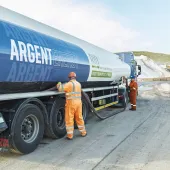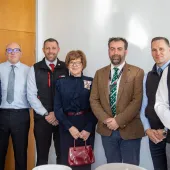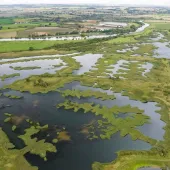Double restoration success for Banks Mining

Mining team reflect on successful restoration of two abandoned East Ayrshire surface mine sites
TRANSFORMING any surface coal mine into an area that can be enjoyed by members of the local community is a complex process which will always present challenges unless carefully planned, more so an abandoned surface mine.
Having restored more than 111 surface mines, Banks Mining have safely and efficiently restored two derelict surface mines, Ponesk and Spireslack, on behalf of the local planning authority, East Ayrshire Council, and the Scottish Mines Restoration Trust (SMRT).
As part of the company’s development with care approach, the mining team quickly established a strong relationship with the local community – a priority for every Banks Mining project – by maintaining an open channel of communication with local residents.
Working with the local communities of nearby Muirkirk and Glenbuck, including the people that live closest to the Ponesk and Spireslack sites, the company was able to plan the work to restore the sites so that it caused the least amount of disruption to people’s daily lives, and included their ideas for the restoration wherever possible too.
A 15-strong, predominantly local, highly skilled and experienced team worked to create the vital landform, visual and safety improvements required following the site’s abandonment in 2013 when previous operators, Scottish Coal, went into administration.
In just over two years, the team transformed the abandoned surface mines into areas which now sit in sympathy with the surrounding landscape and are safely accessible to the public via a newly created network of footpaths and tracks.
The work involved the excavation and reprofiling of more than 6 million tonnes of rock and soil, with a focus on reshaping the overburden mounds on the site to remove steep-sided slopes and create a safer landform.
The abandoned void at Spireslack contains unique geological features of international importance which have been retained, allowing for future development of the site as a Geopark.
It was quickly established that there was little soil available at both sites, meaning the team had to be creative to ensure that the small volume of soil that was available was put to best use to maximize the area which could be covered. Banks Mining also worked closely with SMRT to import compost to boost the available soils resource.
During the mining operations at Ponesk, groundwater levels were managed by pumps, but after the cessation of mining 2013, groundwater levels rose, flooding on to the adjacent A70 road and freezing in winter. To address this issue, the Banks Mining restoration team created a new drainage channel to intercept the groundwater and divert it into the adjacent Ponesk Burn – preventing flooding on the road.
The concept and design of this drainage channel was tabled prior to the commencement of the restoration at the first meeting of the Technical Working Group, which was made up of all interested parties including the Scottish Environment Protection Agency (SEPA).
The local SEPA officer inspected the channel at various stages of its construction and after its completion, making some suggestions with regard to the design that were incorporated into the restoration plan.
The restorations were undertaken with a level of care that meant the natural environment was unaffected and a variety of wildlife – including peregrine falcons, deer, foxes, brown hares, as well as a wide variety of birdlife, including curlews and lapwings – were, and are, often seen across the sites.
Local workers were trained and employed to undertake the work, aligning with the ‘Connect to Banks Mining Charter’, which provides a framework for the training of staff. At Ponesk and Spireslack, all staff were trained to Banks’ high standards of safety and operational responsibility – gaining a level two SVQ in plant operation in the process.
The highly skilled team were able to transform the previously unsightly surface mines into what can be seen today – an attractive landscape in keeping with the surrounding Muirkirk/Glenbuck valley.
Cheryl Hynd, Muirkirk Community Association member, said: ‘The Ponesk and Spireslack sites have now been fully restored by the Banks Mining team and are unrecognizable from their previous state. We are very grateful to Banks Mining and the Scottish Mines Restoration Trust for restoring this piece of lost scenery.
‘What has been achieved is beyond my expectations. I grew up in the old Glenbuck village and have very happy childhood memories of the old village, so it’s great to see the landscape returned to what it was. I never thought I would see it restored in my lifetime.’









